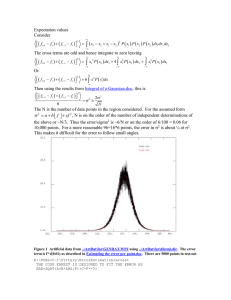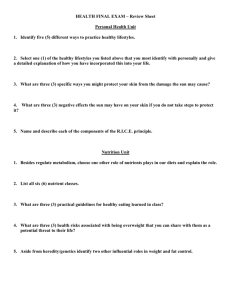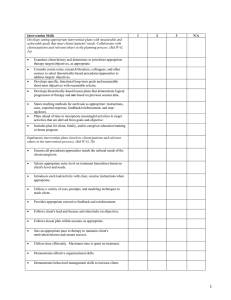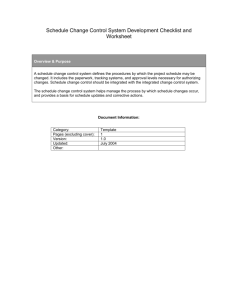The RAND Corporation is a nonprofit institution that research and analysis.
advertisement
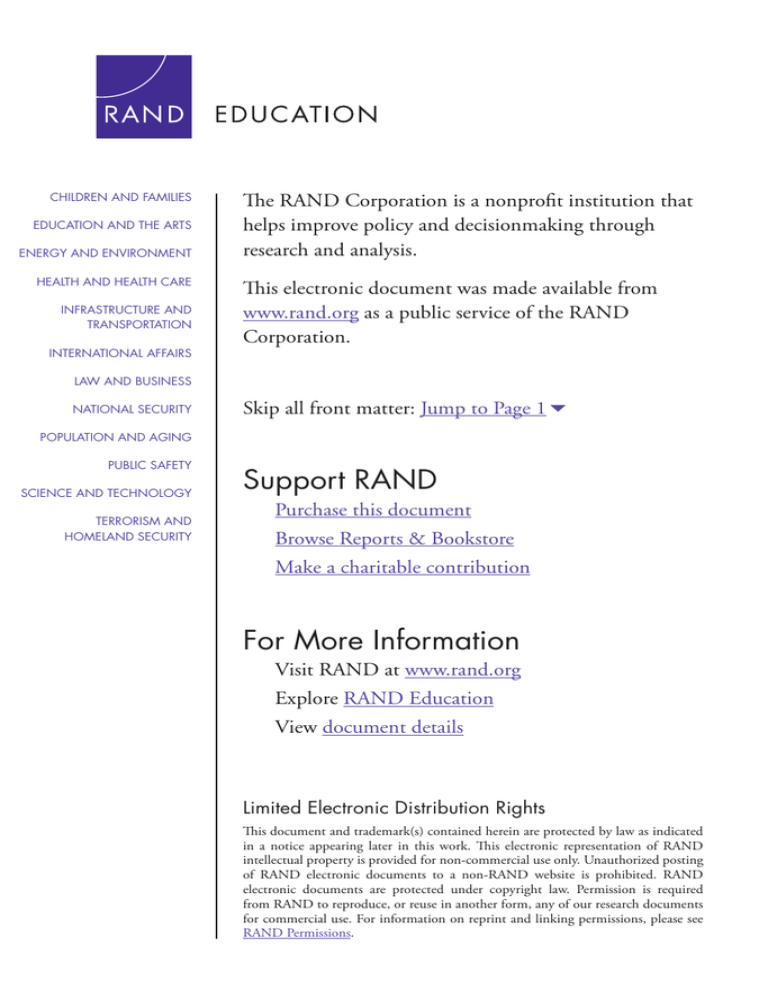
CHILDREN AND FAMILIES EDUCATION AND THE ARTS ENERGY AND ENVIRONMENT HEALTH AND HEALTH CARE INFRASTRUCTURE AND TRANSPORTATION INTERNATIONAL AFFAIRS The RAND Corporation is a nonprofit institution that helps improve policy and decisionmaking through research and analysis. This electronic document was made available from www.rand.org as a public service of the RAND Corporation. LAW AND BUSINESS NATIONAL SECURITY Skip all front matter: Jump to Page 16 POPULATION AND AGING PUBLIC SAFETY SCIENCE AND TECHNOLOGY TERRORISM AND HOMELAND SECURITY Support RAND Purchase this document Browse Reports & Bookstore Make a charitable contribution For More Information Visit RAND at www.rand.org Explore RAND Education View document details Limited Electronic Distribution Rights This document and trademark(s) contained herein are protected by law as indicated in a notice appearing later in this work. This electronic representation of RAND intellectual property is provided for non-commercial use only. Unauthorized posting of RAND electronic documents to a non-RAND website is prohibited. RAND electronic documents are protected under copyright law. Permission is required from RAND to reproduce, or reuse in another form, any of our research documents for commercial use. For information on reprint and linking permissions, please see RAND Permissions. This product is part of the RAND Corporation monograph series. RAND monographs present major research findings that address the challenges facing the public and private sectors. All RAND monographs undergo rigorous peer review to ensure high standards for research quality and objectivity. Errata To: Recipients of MG-1114-FPS, A Big Apple for Educators: New York City’s Experiment with Schoolwide Performance Bonuses--Final Evaluation Report From: RAND Corporation Publications Department Date: September 2011 Re: Corrected pages (pp. 212–214, 220, 221, 223–228) The authors identified errors in the originally published document in Tables 7.9 through 7.14. In each of these tables, the row labels “(std. dev.)” should have been labeled “(std. err.)”. The posted document has been corrected. This error does not affect any other assessments or findings. 212 A Big Apple for Educators Table 7.9 Estimated SPBP Effects on Overall and Component Progress Report Scores, by School Year School Year Progress Report Component Score Overall (std. err.) 2007–2008a –0.39 (1.65) 2008–2009b 2009–2010 b 0.11 –1.32 (1.63) (1.86) Categories Environment (std. err.) Performance (std. err.) Progress (std. err.) –0.06 0.14 (0.27) (0.26) (0.29) 0.15 0.00 –0.31 (0.42) (0.47) (0.52) –0.28 0.01 –0.60 (1.00) (1.02) –0.12 (1.19) Additional credit –0.20 –0.03 –0.29 (std. err.) (0.29) (0.33) (0.28) a High school data for the 2007–2008 school year include only 87 schools with Progress Reports—six control and four SPBP schools were missing data. b Elementary and middle school data for the 2008–2009 and 2009–2010 school years include only 306 schools with Progress Reports—nine SPBP and five control schools were missing data, and four SPBP schools had closed; high school data for the 2008–2009 and 2009–2010 school years include only 87 schools with Progress Reports—four control and six SPBP schools were missing data. the four school years of interest. Across all three program years for elementary, middle, and K–8 levels, we found that SPBP did not improve average student test scores in mathematics and ELA. Average scores for student enrolled in elementary, middle, and K–8 schools invited to participate in SPBP were lower than those for students enrolled in control schools for both subjects and all years, but the differences were small and were statistically significant only for mathematics in the last year. Similarly, across two years for high schools, we found no effect on student test scores in any of the Regents subjects: Comprehensive English, Mathematics A, Mathematics B, Science–Living Environment, Earth Effects on Progress Report and Student Test Scores 213 Table 7.10 Estimated SPBP Effects on Overall and Component Progress Report Scores for Elementary and Middle Schools, by School Year Progress Report Component Score Overall Score (std. err.) School Year 2007–2008 2008–2009a 2009–2010a 0.21 –1.14 –2.62 (1.82) (1.42) (2.02) –0.17 Categories Environment (std. err.) Performance (std. err.) Progress 0.00 0.11 (0.29) (0.28) (0.32) 0.33 –0.04 –0.35 (0.46) (0.44) (0.44) 0.10 –0.95 –1.64 (std. err.) (1.14) (0.97) (1.37) Additional credit –0.22 –0.25 –0.46 (std. err.) (0.32) (0.35) (0.32) a Data for the 2008–2009 and 2009–2010 school years include only 306 schools with Progress Reports—nine SPBP and five control school were missing data, and four SPBP schools had closed. Science, and Chemistry. The next section begins with a brief description of our analytic approach, followed by a summary of findings. Analytic Approach As discussed previously, we used an ITT analysis to estimate how SPBP might affect student achievement test scores. We produced estimates for high schools separately from those for elementary, middle, and K–8 schools because Regents Exams differ from the exams administered to students in grades 3 through 8. The content assessed on Regents Exams is more narrowly focused than that for the lower grades. Students can also select when to take Regents Exams and can sit for an exam multiple times. Although we restricted our analysis sample to scores from 214 A Big Apple for Educators Table 7.11 Estimated SPBP Effects on Overall and Component Progress Report Scores for High Schools, by School Year Progress Report Component Score Overall Score (std. err.) School Year 2007–2008a 2008–2009b 2009–2010 b –2.68 2.64 4.63 (3.85) (3.69) (3.44) –0.29 0.12 0.22 (0.66) (0.58) (0.54) –0.56 –0.35 0.51 Categories Environment (std. err.) Performance (std. err.) Progress (std. err.) Additional Credit (std. err.) (1.01) (0.95) (1.09) –1.71 2.34 3.65 (2.04) (2.16) (1.99) 0.53 0.25 (0.71) (0.59) –0.12 (0.67) a Data for the 2007–2008 school year include only 87 schools with Progress Reports—six control and four SPBP schools were missing data. b Data for the 2008–2009 and 2009–2010 school years include only 87 schools with Progress Reports—four control and six SPBP schools were missing data. the first time a student took a specific examination,7 the lack of uniformity on assessments and the assessment process across the different grade levels could have produced systematic differences in the SPBP 7 The common interpretation of the SPBP effect on achievement is the average of the difference between a student’s achievement had the student been enrolled in a school participating in SPBP and the achievement had the student been enrolled in a school not participating in SPBP. Because high school students have some flexibility in taking the Regents Exams, SPBP could affect which students take an exam and when; for students who take the exam, it could also affect performance. Our estimate of the SPBP effect combines the effects on who takes each exam and how they perform. It describes how much, on average, we might expect student achievement on the Regents Exams to change because of a school’s participation in SPBP. Our high school analyses did not estimate how much an individual student’s performance would change as a result of the school’s participation in the program. For elementary and middle school grades, the tests are mandatory, and we interpreted the SPBP effect for schools with those grades as the average effect on the achievement of an individual student. 220 Year 1 Year 2 No Controls Controls Year 3 No Controls Controls Years 1, 2, and 3 No Controls Controls No Controls Controls Scale Scores Mathematics (std. err.) –1.20 –0.97 –1.63 –1.59 –2.13* –1.93* –1.65 –1.57 (1.08) (0.89) (1.05) (0.90) (1.07) (0.96) (1.01) (0.86) 111,014 111,014 108,093 107,953 108,555 107,976 327,662 326,943 0.10 0.23 — — (std. err.) — — (0.78) (0.65) Observations — — 105,483 105,330 R2 — — 0.04 0.18 0.08 Observations R2 ELA Student and school controls 0.09 0.20 0.09 0.22 0.10 0.22 –0.69 –0.80 –0.90 –0.91 — — (0.66) (0.58) — — 105,303 105,269 — — 0.24 — — √ √ √ √ Standardized Scores Mathematics –0.03 –0.02 –0.05 –0.04 –0.06* –0.06* –0.05 –0.04 (std. err.) (0.03) (0.02) (0.03) (0.02) (0.03) (0.03) (0.03) (0.02) Observations 111,014 111,014 108,093 107,953 108,555 107,976 327,662 326,943 0.00 0.15 0.01 0.13 0.01 0.15 0.01 0.14 R2 A Big Apple for Educators Table 7.12 SPBP Effects on Test Scores for Elementary, Middle, or K–8 Schools, by Subject and School Year (ITT Estimates) Table 7.12—Continued Year 1 Year 2 No Controls Controls ELA Year 3 No Controls Controls Years 1, 2, and 3 No Controls Controls No Controls Controls — –0.02 –0.03 –0.03 –0.03 — — — — (0.02) (0.02) (0.02) (0.02) — — Observations — — 105,483 105,330 105,303 105,269 — — R2 — — 0.00 0.15 0.01 0.18 — — Student and school controls √ √ √ √ Number of schools Treatment 191 187 187 191 Control 133 133 132 133 NOTES: *, **, *** Estimates are statistically significant from zero at the 5%, 1%, and 0.1% levels, respectively. Student-level controls include gender, race and/or ethnicity, ELL status, special education status, free or reduced-price lunch status, retention flag, and grade level. School-level controls include male students (%), students by race and/or ethnicity (%), free and reduced-price lunch students (%), school size, and school level. The referant categories are grade 8, white, female, white (%), female (%), K–8 schools, and year 3. Four of the 324 in the elementary, middle, and K–8 sample were excluded from the analysis because they did not enroll students in at least one tested grade (grades 3–8). Standard errors appear in parentheses. Year 1 and three-year combined results for ELA are excluded because testing occurred early in the school year, before effects could occur. Effects on Progress Report and Student Test Scores — (std. err.) 221 Table 7.13 SSPBP Effects on Regents Exams Scores for High Schools, by Subject and School Year: Scale Scores (ITT Estimates) Fall Test Administration Fall, Year 2 Spring Test Administration Spring, Year 1 Spring, Year 2 Controls No Controls Controls No Controls Controls 0.62 0.72 0.39 –0.56 2.23 1.72 (std. err.) (2.01) (2.14) (1.79) (1.63) (1.52) (1.37) Student Observations 8,234 8,234 10,276 10,276 9,345 9,345 82 82 84 84 82 82 0.00 0.17 0.00 0.15 0.00 0.19 Mathematics A 0.26 0.48 –0.16 0.54 — — (std. err.) (0.81) (0.66) (1.07) (0.97) — — Student Observations 8,469 8,469 11,907 11,907 — — 82 82 82 82 — — School Observations R2 School Observations R2 0.00 0.09 0.00 0.10 — — Mathematics B –0.66 –0.88 –2.32 –0.19 –2.72 0.97 (std. err.) (3.13) (2.38) (2.66) (2.20) (2.72) (2.28) Student Observations 1,299 1,299 1,914 1,914 1,813 1,813 62 62 66 66 72 72 0.00 0.10 0.00 0.11 0.01 0.11 School Observations R2 Effects on Progress Report and Student Test Scores No Controls ELA 223 224 Fall Test Administration Fall, Year 2 Spring Test Administration Spring, Year 1 Spring, Year 2 No Controls Controls No Controls Controls No Controls Controls 0.65 1.36 1.14 1.58 –1.14 –0.28 (std. err.) (1.09) (0.78) (1.06) (1.11) (1.04) (1.03) Student Observations 7,170 7,170 10,447 10,447 16,062 16,062 Integrated Algebra School Observations R2 Science–Living Environment 81 81 80 80 82 82 0.00 0.08 0.00 0.09 0.00 0.09 0.08 –0.42 0.15 0.27 –0.36 0.30 (std. err.) (1.21) (1.20) (1.07) (1.08) (1.12) (1.17) Student Observations 7,903 7,903 11,953 11,953 12,540 12,540 82 82 81 81 81 81 School Observations R2 0.00 0.07 0.00 0.09 0.00 0.13 –2.38 –2.03 –2.70 –2.84 –1.36 –1.89 (std. err.) (2.82) (2.22) (1.85) (1.87) (2.12) (2.11) Student Observations 1,490 1,490 5,856 5,856 6,197 6,197 Earth Science School Observations R2 50 50 68 68 68 68 0.01 0.10 0.01 0.11 0.00 0.10 A Big Apple for Educators Table 7.13—Continued Table 7.13—Continued Fall Test Administration Fall, Year 2 No Controls Spring, Year 1 Controls No Controls Controls Spring, Year 2 No Controls Controls –3.76 –3.56 0.01 0.13 1.62 3.40 (5.74) (3.10) (2.02) (1.88) (2.38) (2.14) Student Observations 316 316 2,869 2,869 2,705 2,705 School Observations 31 31 62 62 57 57 0.02 0.41 0.00 0.08 0.00 0.12 (std. err.) R2 Student and school controls √ √ √ NOTES: *, **, *** Estimates statistically significant from zero at the 5%, 1%, and 0.1% levels, respectively. Student-level controls include gender, race and/or ethnicity, free/reduced lunch status, and indicators if gender or race and/or ethnicity was undefined. School-level controls include the percentage of male students, percentage of students by race and/or ethnicity, percentage of free/reduced price lunch students, school level and school size. The number of schools containing at least one student with valid test score information ranges between 31 (Chemistry, fall 2008) and 84 (ELA, spring 2008). Table does not contain estimates for Mathematics–A in spring 2009 because of insufficient number of valid test scores. Standard errors appear in parentheses. Effects on Progress Report and Student Test Scores Chemistry Spring Test Administration 225 226 Fall Test Administration Fall, Year 2 Spring Test Administration Spring, Year 1 Spring, Year 2 No Controls Controls No Controls Controls No Controls Controls 0.04 0.04 0.02 -0.03 0.13 0.09 (std. err.) (0.11) (0.11) (0.09) (0.08) (0.07) (0.07) Student Observations 8,234 8,234 10,276 10,276 9,345 9,345 82 82 84 84 82 82 0.00 0.17 0.00 0.14 0.00 0.19 Mathematics A 0.02 0.04 -0.01 0.04 … … (std. err.) (0.07) (0.05) (0.08) (0.07) … … Student Observations 8,469 8,469 11,907 11,907 … … 82 82 83 83 … … ELA School Observations R2 School Observations R2 0.00 0.08 0.00 0.09 … … Mathematics B -0.04 -0.05 -0.13 0.01 -0.15 0.05 (std. err.) (0.19) (0.14) (0.15) (0.13) (0.15) (0.13) Student Observations 1,299 1,299 1,914 1,914 1,813 1,813 62 62 66 66 72 72 0.00 0.08 0.00 0.07 0.01 0.08 School Observations R2 A Big Apple for Educators Table 7.14 SPBP Effects on Regents Exams Scores for High Schools, by Subject and School Year: Standardized Scores (ITT Estimates) Table 7.14—Continued Fall Test Administration Fall, Year 2 Spring Test Administration Spring, Year 1 Spring, Year 2 Controls No Controls Controls No Controls Controls 0.05 0.11 0.08 0.12 -0.08 0.22 (std. err.) (0.09) (0.06) (0.08) (0.08) (0.08) (0.07) Student Observations 7,170 7,170 10,447 10,447 13,855 13,855 School Observations R2 Science–Living Environment 81 81 80 80 82 82 0.00 0.08 0.00 0.09 0.00 0.09 0.01 -0.03 0.01 0.02 -0.03 0.02 (std. err.) (0.09) (0.09) (0.08) (0.08) (0.08) (0.09) Student Observations 7,903 7,903 11,953 11,953 12,540 12,540 82 82 81 81 81 81 School Observations R2 Earth Science 0.00 0.07 0.00 0.09 0.00 0.12 -0.15 -0.13 -0.16 -0.17 -0.08 -0.12 (std. err.) (0.18) (0.15) (0.11) (0.11) (0.13) (0.13) Student Observations 1,490 1,490 5,856 5,856 6,197 6,197 School Observations R2 50 50 68 68 68 68 0.01 0.09 0.01 0.10 0.00 0.09 Effects on Progress Report and Student Test Scores No Controls Integrated Algebra 227 228 Fall Test Administration Fall, Year 2 Chemistry (std. err.) Student Observations School Observations R2 Student and school controls Spring Test Administration Spring, Year 1 Spring, Year 2 No Controls Controls No Controls Controls No Controls Controls -0.30 -0.28 0.00 0.01 0.13 0.26 (0.45) (0.24) (0.17) (0.16) (0.18) (0.17) 316 316 2,869 2,869 2,705 2,705 32 32 62 62 57 57 0.09 0.39 0.00 0.05 0.00 0.11 √ √ √ NOTES: *, **, and *** Estimates are statistically significant from zero at the 5%, 1%, and 0.1% levels, respectively. Student-level controls include gender, race and/or ethnicity, free or reduced-price lunch status; indicators of gender or race and/or ethnicity were undefined. School-level controls include male students (%), students by race and/or ethnicity (%), free and reduced-price lunch students (%), school level, and school size. The number of schools containing at least one student with valid test score information ranged between 31 (chemistry, fall 2008) and 84 (ELA, spring 2008). Table does not contain estimates for Mathematics A in spring 2009 because of insufficient valid test scores. Standard errors appear in parentheses. A Big Apple for Educators Table 7.14—Continued
